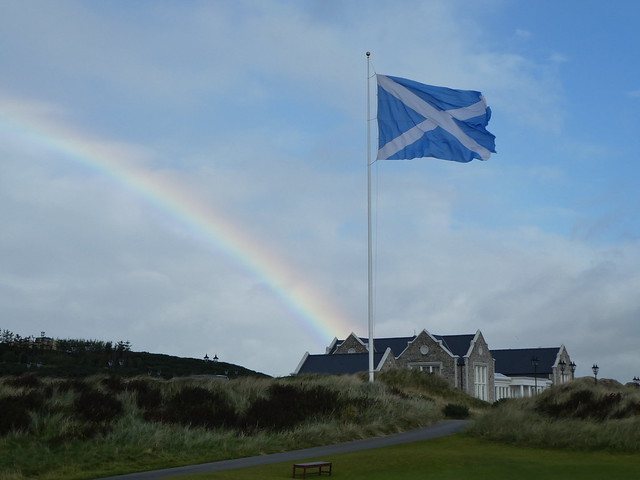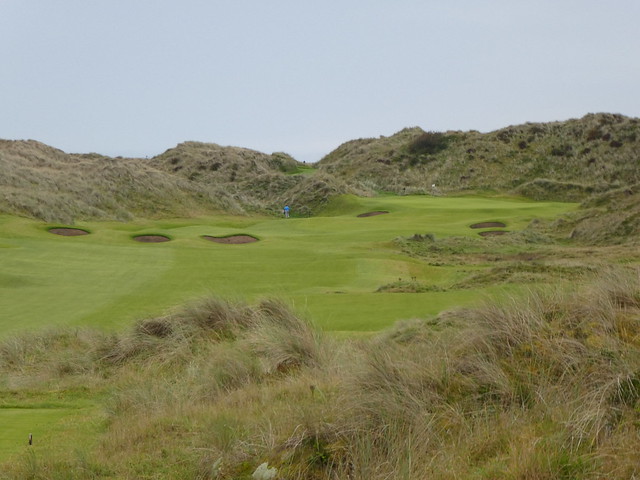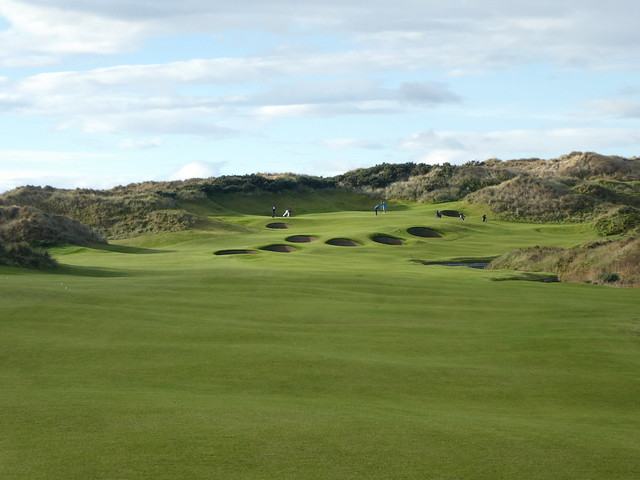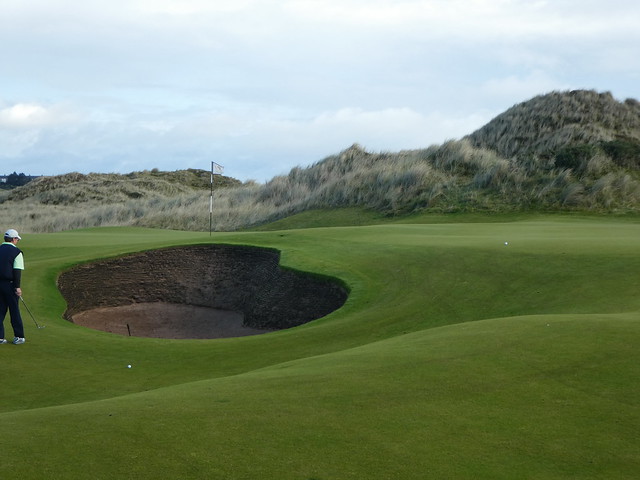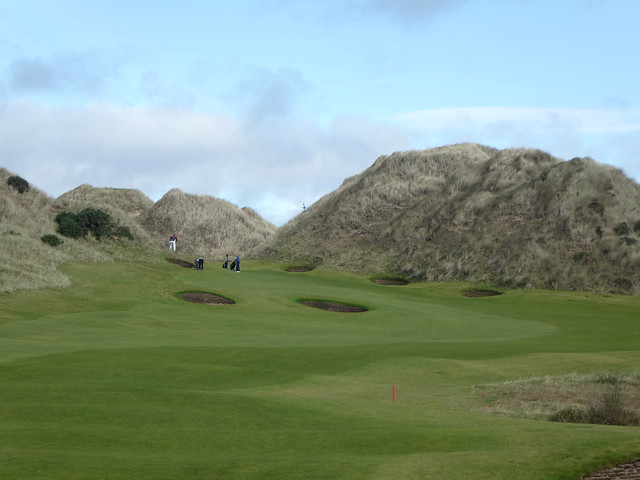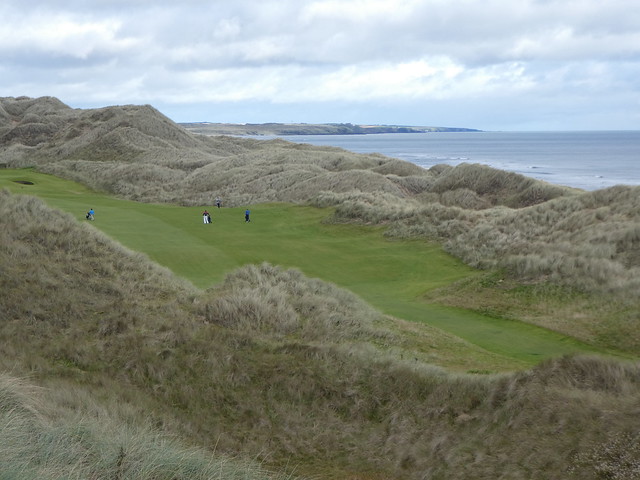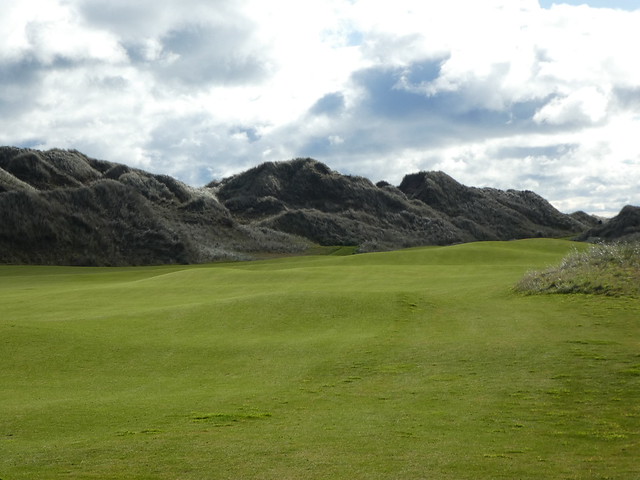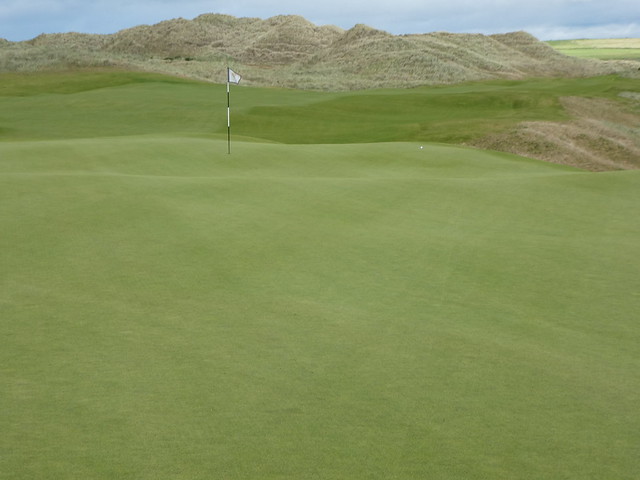What does the Trump International Links Scotland have in
common with Meryl Streep, Alec Baldwin, the play Hamilton, and Saturday Night
Live? It is totally overrated! While visually stunning, the course has some
serious design issues that make is less than enjoyable to play. It’s like a difficult
child that tries too hard to be cute and ends up being annoying.
Opened among much fanfare and publicity, I had high
expectations that the course would be great. Unfortunately, there are a host of problems at
this new links, among them: 1) the severe nature of the rough; 2) the overly
penal nature of the green contours, in particular, the nasty fall-away on all
sides, and the multi-tiering; 3) a routing that lacks enough change in direction; and,
4) a steep greens fee.
For the record, this is a blog about golf courses and not
politics. My commentaries are about the course, not the man. In the interest of
fairness, I approach his courses with an open mind. I liked Trump Ferry Point quite a bit and recommend it. This course, however, totally
misses the mark. To my learned friends who are raters who somehow ranked this
among the best in the world, I think you’ve lost your minds.
The course is built on a property that sprawls across 2,000 acres adjacent to the North Sea, north of Aberdeen and south of Cruden Bay. The
sand dunes on the Aberdeen coast are among the world’s most dramatic, some as
large and tall as Grand Central Station. The course sits on a spectacular piece of land and what a shame
it wasn’t taken better advantage of. While playing at the Trump course at
Bedminster, New Jersey, the manager of the course, who played with us, told us
on each hole how Donald had given instructions to the course architect, Tom Fazio, telling him what he wanted to do. It seemed to me that he dictated a lot of the
design elements (all for the worse in my view, making the course too
difficult), so in fairness to the architect of Trump International Links
Scotland, Martin Hawtree, I would speculate that all the design choices might
not have been his. My further speculation would be that the owner had
difficulty in mind when giving the architect guidance on the course design. It
appears to have been designed for an Open Championship it will never get, and not
for the recreational golfer. The blue tees play to a sky-high rating/slope of
73.8/140. What a shame that the mandate and result prioritized difficulty above all
else.
The first hole, a 500-yard par five, like many holes, plays
from an elevated tee. Your opening tee shot offers much promise: the grass is
lush, the pot bunkers are artfully placed, and the contrast of the green fairways against the brown of the dunes presents an appealing environment. The fairway
on this hole is generous, the tricked-up nature of the course reveals itself,
sadly, once you reach the green. There is a false front and the green falls
away on the right. As with almost every green on the course,
the green is multitiered. The overall impact of the design is to reduce the
effective landing area a golfer can hit into to about one third of the actual size
of the green. I suppose this is a crafty design element if you have pinpoint
control on your irons and can hit a ball through the wind to a target 10 feet
by 10 feet in size. I didn’t find it as enticing. I found unnecessary and tedious.
The third hole, a par three set in the dunes, follows the
same formula as the first two holes: a multi-tiered, tricked-up green that
repels balls from all directions. The golfer must enjoy the sound of the nearby
North Sea as they play this hole since this is a close as you will get to it. This is another missed
opportunity in my view, although, in fairness, my guess is that more holes couldn't be built near the water due to environmental
regulations today and they weren’t allowed to get closer like the other great links
in this country built a century earlier? Given all the hype, I anticipated this
would be a course that takes great advantage of being near the sea. Nearby
Cruden Bay occupies a headland and you have views from on-high looking out over
the water frequently. With only one or two exceptions you are blocked out of sweeping views of the
water by the high dunes at Trump International.
Would you be surprised at this point to learn that the par-five fourth green is also uber-undulating and repels almost all balls aimed at it? Really?
The fourth green complex
The fourth hole confirmed a nagging suspicion that I developed on the first three holes: that the greens on the whole course are unfair and too penal. While the array of bunkers to the elevated green is visually beautiful, playing golf on the hole is not fun. Again, the effective landing area to not have a ball repelled off the green is too small. And, the course design inexplicably takes away bump and run shots, one of the bread and butter shots in the home of golf. The elevated nature of almost all the greens is not suited to true bump and run shots. Instead, we played pitch shots all day, flying them through the air to get over the false fronts and to the correct tier. All this particular green is missing is a windmill on the back.
The pretty fourth hole as seen from the fairway
While I'm in the middle of my tirade, did I mention that the rough on the course is thick and dense? A ball that does
not land on the fairway is lost. With certainty. There is a zero probability
that you will find a ball that goes awry. Nil. Zilch. Bye Bye.
This can be frustrating to say the least. My armchair
architect design observation is that the fairways are too narrow for a windy
environment. Ok, I can hear some readers saying, hit the fairway and you won’t
have a problem, you hack. Easier said this done in a country known for the
stiffness of its chilly breezes. And, I am fine with a penalty for a poorly hit
shot. Why not design it like Shinnecock Hills, where if you hit into the fescue
you can at least find your ball and then hit a wedge out? At Trump
International Links Scotland you have no such chance because your ball is immediately
and irrevocably lost. The areas off every
fairway may as well be water, since the result of an off line shot is the same: you return to your
bag to fish out another ball.
We enter a picture of the fifth green as exhibit A, your honor, to show the crazy nature of the greens and their surrounds
The par-3 sixth hole was my least favorite on the course and
one of the least enjoyable holes I have ever played. It is a postage stamp
green with heavy rough left and a long and big drop off right (the course guide
describes it with masochistic glee as a cavernous drop). The wind was blowing
stiff from left to right the day we played and my ball landed on the right side
of the green and then bounced hard right and was lost. Are we having fun yet?
Like all the greens on the course, the effective landing area is about one
third the actual size of the green, making it unduly penal. I have played
difficult holes in my day, including the original Postage Stamp hole at Royal
Troon. Difficult, but, at least if you miss by a little bit you can still chip
or pitch or hit out of a bunker. Losing a ball left or right (or I’m sure short
shots are lost also) is not conductive to an enjoyable day on the links. Other
than that Mrs. Lincoln, how did you enjoy the play?
Every golfer in my group lost our balls on our tee shots
on the 7th, 8th, and 9th holes. By the ninth hole I was thinking of taking up
tennis or bird watching. The entire point of playing golf is to have fun and
no-one in our group (high handicappers and low) had fun. The course is just too
much of a grind. My regular readers know that I am an average golfer. The
others in my group were low handicappers and they had the same reaction and
results as I did. The near-scratch golfer in our group was so frustrated he simply hit a 3-iron off every tee on the back so as not to lose balls.
When you think of great golf courses, one common element they all have is a great routing with a continual change in direction. Examples that come to mind are Cypress Point, Pine Valley, Carnoustie, Sunningdale, Prestwick, Cruden Bay, Royal Portrush, Royal County Down and Castle Stuart. This change in direction is particularly important on links courses where the golfer needs an occasional respite when the wind is up. Carnoustie, for example, has no more than two holes that play consecutively in the same direction before there is a change. Trump International Golf Links inexplicable doesn’t have such a routing, which would have been easy enough to do, one suspects, through the dunes.
Lest you think the author exaggerates, imagine your ball flying into this? Arrivederci, as we say in Italian.
When you think of great golf courses, one common element they all have is a great routing with a continual change in direction. Examples that come to mind are Cypress Point, Pine Valley, Carnoustie, Sunningdale, Prestwick, Cruden Bay, Royal Portrush, Royal County Down and Castle Stuart. This change in direction is particularly important on links courses where the golfer needs an occasional respite when the wind is up. Carnoustie, for example, has no more than two holes that play consecutively in the same direction before there is a change. Trump International Golf Links inexplicable doesn’t have such a routing, which would have been easy enough to do, one suspects, through the dunes.
The routing at Trump Golf Links Scotland fails the enjoy-ability test. The first
four holes are routed out from the clubhouse toward Aberdeen in the south. The
course then changes direction with the following seven holes(!) routed back in
the opposite direction. It isn’t until the 13th hole that the course deviates
from its strict north-south heading and plays east toward the North Sea.
Seventeen holes on the course play parallel to the water (and the wind on the day I played) and only
one goes east-west. Over time I think the course will have to be softened in
order to make it more playable, however, this unconventional and unvaried routing might be the kill shot, I’m not sure they could reroute holes to improve
the play-ability without going back to the drawing board.
The
course routing lacks enough change in direction to be among the best in the
world. Personally, I wouldn’t even rank it among the top 500 courses I have
played. In fairness, on the day I played, the prevailing wind was a cross wind:
it was blowing off the mainland out toward the North Sea. Apparently, the
prevailing wind is from the south, which helps somewhat because at least the golfer is hitting either into the wind or down wind, although I stick to my basic premise about the lack of variety being bad. Playing seventeen holes in a
cross-wind is not fun. Golf course architects surely know that the winds in
Scotland are changeable? Why would you route so many holes parallel on the sea?
It really makes no sense to me. Why route all the holes along the dunes, why
not route some back and forth to play through the dunes, like at nearby Cruden
Bay? I’m still scratching my head.
I will bet anyone who will take me up on it £10 that the course
will look quite different in ten years time. In order to salvage it, the
fairways must be widened, the rough must be thinned and the greens must be
softened. Not much can be done I suspect about all the parallel holes, but at
least it won’t be a complete debacle.
To prove that I’m not a total curmudgeon, I did like the
back nine better than the front; the fairways are a bit wider, it has the one
hole (the par 3 13th) that changes direction toward the North Sea, and the holes are
slightly more fair and interesting. The 10th hole was probably my favorite on
the course, a par five that gets progressively more narrow as you approach the
green. The hole also rises from tee to green a significant elevation. The
course guide says that the hole plays through The Great Dunes of Scotland, in italics. I’m not familiar with this
term and assume that it is a marketing ploy to try to name these dunes similar
to the way that Royal St. George's has the Sahara bunker and Royal Portrush has the Big Bertha bunker.
Since I didn’t ask permission to use the term in my blog I hope I don’t get a
letter from the courses’ lawyers claiming I infringed on their copyright!
The nice par five tenth hole works well from tee to green provided you can hit a ball precisely on your intended target line with no deviation whatsoever
The par four 14th hole is also beautifully framed by the rugged dunes. I can see how many are awed by the amazing dunes, and if the wind weren't blowing and it weren't so penal it might actually be a very pleasant place to play golf.
The course is unmistakably pretty as seen in the contrast of
the enormous sand dunes set against the lush green grass above.
The overdone green contouring, fall-aways and false
fronts continue until the end of the round. Variety is the spice of life. Here, no such variation exists; the repetition simply tedious.
On the positive side, the course conditions were fabulous,
the grass is lush and the greens (if you can ever get on them) and in good
condition and fast. Giving credit where it is due, the holes do have a variety
in length. There is a nice combination of short, medium, and long par threes
and fours. The staff was amenable and friendly and the clubhouse was
surprisingly understated and tasteful.
If you are in the Aberdeen area my recommendation would be
to skip this course altogether and play at Royal Aberdeen, Murcar Links, and
multiple times at Cruden Bay. Your experience will be fun and your greens fees more reasonable: Trump (£235), Royal Aberdeen (£180),
Murcar Links (£130), and Cruden Bay (£125).
One area that I did find the course is distinctive: we played on a Saturday morning and the course was empty, people didn't seem to be flocking to the venue. Not many public courses can make that statement. My further prediction is just like Trump Bedminster was at one time ranked in the top 100 because of a P.R. blitz and then dropped off after the fanfare subsided, Trump International Golf Links will continue to sink and will settle roughly in the same spot as Western Gailes (the course it most closely resembles), well out of the top 100 ranked courses in the world.
The good news is that in a country of must play golf courses, when it is hard to fit in all the golf you want to play as you are planning an itinerary and traveling around touring great courses, the choice here is easy. This is a must skip golf course.
One area that I did find the course is distinctive: we played on a Saturday morning and the course was empty, people didn't seem to be flocking to the venue. Not many public courses can make that statement. My further prediction is just like Trump Bedminster was at one time ranked in the top 100 because of a P.R. blitz and then dropped off after the fanfare subsided, Trump International Golf Links will continue to sink and will settle roughly in the same spot as Western Gailes (the course it most closely resembles), well out of the top 100 ranked courses in the world.
The good news is that in a country of must play golf courses, when it is hard to fit in all the golf you want to play as you are planning an itinerary and traveling around touring great courses, the choice here is easy. This is a must skip golf course.
